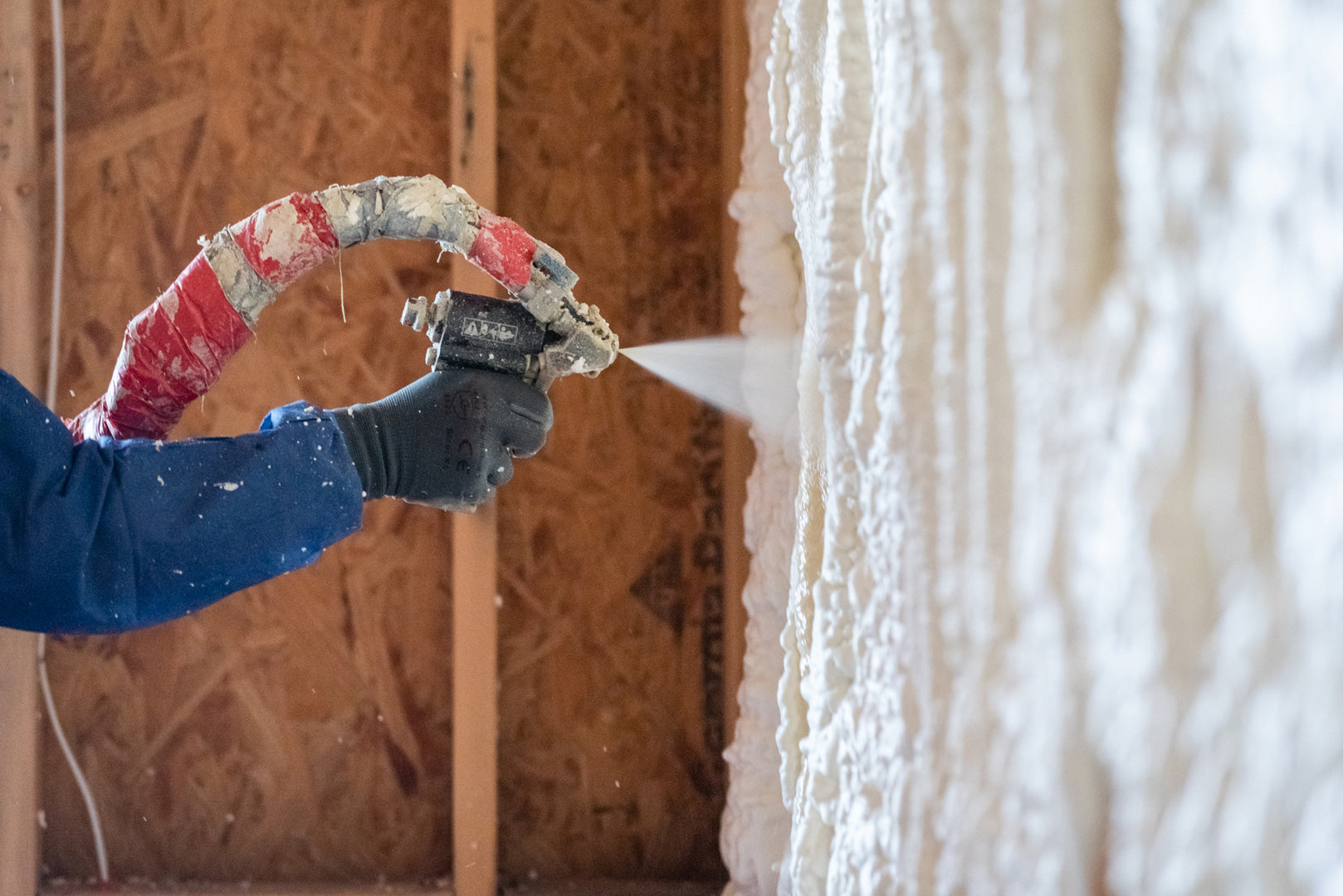Can You Put Drywall Over Spray Foam? Guide for Homeowners
Are you thinking of adding spray foam to your home's insulation but not sure about drywall? This guide will examine the question of whether you can put drywall over spray foam. It's aimed at homeowners eager for insights.

Spray foam insulation is now a favorite for better energy use and home coziness. Yet, combining it with drywall brings its hurdles. We'll talk about the need for vapor barriers, how to keep things safe from fires, what the code says, and ways to prep walls. Plus, we cover installing the spray foam and then the drywall.
Our advice comes from experts at VB Insulation for getting your house renovation right and meeting the rules. We'll focus on controlling moisture, improving heat use, drowning out sound, and cost-saving steps for older homes.
Key Takeaways
- Spray foam insulation can be installed over existing insulation, but it's essential to remove old materials first to avoid sealing in issues like moisture and animal activity.
- Proper preparation of the wall cavities, including exposing them and protecting surrounding areas, is crucial for a successful spray foam installation.
- Adhering to building code requirements for vapor barriers, fire safety, and other insulation standards is essential when installing drywall over spray foam.
- Partnering with experienced insulation contractors can help homeowners maximize the energy-efficient benefits of spray foam while ensuring a high-quality, code-compliant installation.
- Upgrading insulation is a smart investment for a more comfortable, energy-efficient, and cost-effective home.
Understanding Spray Foam Insulation
Vega Bond V600 insulation kit is a top choice for many homeowners. It helps make houses more energy-efficient and comfy. You can put it on walls, in attics, and more. It keeps air out, makes the home cooler in summer and warmer in winter, and makes your place quieter.
Types of Spray Foam Insulation
There are two types of spray foam: open-cell kits and closed-cell kits. Open-cells are lighter and have less insulation power. Closed cells are denser and keep your house warmer. The one you pick depends on your home's needs, like the weather, the layout, and the money you want to spend.
Benefits of Spray Foam Insulation
Spray foam can do a lot to improve your home. It seals in the air, keeps your house at the right temperature, controls moisture, and reduces noise. All of this can save you money and energy and make your place feel nice and quiet inside.
Importance of Proper Installation
Getting spray foam installed correctly is so important. Professionals should do it to avoid problems like heat loss, dampness, or wrong building rules. Choosing a good insulation company like VB Insulation means you'll get all the good stuff spray foam offers without any worries.

Removing Existing Insulation
Before adding new spray foam, it is key to remove old insulation. This includes materials like fiberglass or cellulose from the walls. If not removed, it might make the new foam less effective.
Why Remove Old Insulation?
It's best to have pros remove old insulation. Doing it yourself is risky and might need to be done right. Companies like VB Insulation know how to do it safely.
Hiring Professional Insulation Contractors
A professional home energy audit can identify the best places for spray foam, which helps with the renovation plan. With experts, homes can properly remove old insulation and install new, better spray foam.

Can You Put Drywall Over Spray Foam?
Installing drywall over spray foam insulation is possible but requires careful steps. Important factors to consider include preparing correctly and following local rules for safety and quality.
Vapor Barrier Requirements
Spray foam can be open-cell or closed-cell, each with its vapor barrier needs. It's wise to speak with insulation experts, like those at VB Insulation, who can help you find the right barrier for your project.
Fire Safety Considerations
Spray foam is flammable, making fire safety essential. Gypsum drywall is usually required as a protective layer. It acts as a fire barrier. Following these fire safety rules keeps your home safe.
Building Code Compliance
Strict local rules govern the placement of drywall over spray foam. Both homeowners and contractors must follow these rules for safety, and working with professionals like VB Insulation ensures you do things the right way.
Preparing Walls for Spray Foam Installation
Before installing spray foam insulation, you must remove existing drywall. This step is key. It allows the spray foam to fill the wall cavities perfectly, giving the best insulation and sealing the air well.
Exposing Wall Cavities
Getting rid of old drywall lets the spray foam insulation team from VB Insulation reach the walls. They can then directly apply the foam to the frame. This method helps the foam expand properly, sticking to the whole area. It creates a tight barrier for better insulation and sealing. This also improves how well the walls keep in heat and block out air.
Protecting Surrounding Areas
It is important to ensure the area around the walls is safe during the insulation. This protects your floors, furniture, and other parts of your home from any spray. The crew at VB Insulation knows how to shield these places. They use the right gear and methods to make sure your space stays neat during the work.
Getting the walls ready right before adding spray foam insulation is a must. It's a crucial step for a job done well and up to code.
Installation Process of Spray Foam Insulation
The installation of spray foam insulation is done with great care. It is applied in thin layers, allowing each layer to expand and stick well to the walls. This method avoids problems like bowing in drywall or the insulation not hardening properly.
Spraying in Lifts
At VB Insulation, professionals know how to layer the spray foam correctly. They use a method that ensures the foam expands well but doesn't push against the walls too hard. This careful work gives the best insulation and effectively seals the air spaces.
Proper Curing Time
Each foam layer must have time to cool and harden before the next is added. This waiting period is crucial for the insulation to work right. Following the guidelines from manufacturers and building codes is important to keep energy savings and safety in check.
Drywall Installation Over Spray Foam
First, the spray foam insulation must be installed correctly and fully dried. Then, the drywall is put up over it, creating a sleek inside finish. It's very important to pay close attention and follow the best steps when putting up the drywall, as this keeps the spray foam working well.
Moisture Control Measures
Keeping moisture under control is crucial when adding drywall over spray foam. The drywall needs space to breathe and let out any trapped moisture. Professionals from places like VB Insulation know how to make sure the drywall breathes right. They'll hang it securely without any problems.
Drywall Hanging Techniques
The right drywall hanging techniques matter a lot. One technique is to make a small gap between the drywall and the ground. This gap aids air movement and stops moisture from getting stuck. This helps the drywall work well with the spray foam. Together, they improve the home's heating and cooling efficiency.
| Metric | Recommended Value |
|---|---|
| Screw Spacing for Drywall Over Spray Foam in Vaulted Ceilings | Majority of users recommend using screws in addition to glue, with spacing reduced from 12" to 16" when gluing ceilings |
| Spacing for Walls Spray Foamed | 24" spacing with mastic adhesive or 48" spacing with foam adhesive |
| Proper Glue Application | 3/8" bead of glue along each stud |
| Difficulty of Removal for Glued Drywall | Significantly more difficult compared to nails or screws |
| Benefits of Glue | Correcting minor stud issues, increasing sound transmission class (STC) ratings, and allowing for structural movement without breaking the bond |
Energy Efficiency and Cost Savings
When done right, spray foam insulation can save homeowners a lot of money. It seals air leaks and improves homes' ability to keep heat or cool air in, cutting down on heating and cooling costs.
Reducing Energy Bills
Using spray foam, newer or better-insulated homes might save 10-15% on their energy bills. However, older homes with less insulation could cut their bills by 20-30%. Houses built before 1990 that have block walls might save 15-25% with spray foam.
If you install spray foam, your home will be more comfortable, too. It helps keep a steady temperature, control moisture, and reduce noise. This makes choosing spray foam a smart move for anyone wanting to make their house nicer, whether in a big renovation or a small fix. Working with pros like VB Insulation can really squeeze the most from your investment in spray foam and drywall.
Conclusion
It's possible to put up drywall over spray foam insulation. But for it to work well, you need to follow some critical steps. First, you have to prepare the wall areas correctly. Then, make sure you use the right vapor barriers and meet fire safety rules. Finally, obey local building codes.
Getting help from pros in insulation and construction, like VB Insulation, is a good idea. This ensures your job goes smoothly. By taking the right steps and using spray foam well, your home can become more comfy. You'll save money on energy, too. A home project can be a big success this way.
When spray foam and drywall are combined smartly, they boost your home a lot. You get better energy use, handle moisture well, and live more comfortably. But it's key to know what's required and to follow the rules. This way, you get all the benefits and avoid troubles. With the right help, you can turn your home into a safe, energy-saving, and cozy place.
FAQ
Can you put drywall over spray foam insulation?
Yes, you can install drywall over spray foam insulation. But it's important to do it right and meet all the necessary requirements.
What are the vapor barrier requirements for installing drywall over spray foam?
The type of foam you use (open-cell or closed-cell) affects vapor barrier needs. You must follow specific guidelines to avoid moisture problems. Keeping moisture under control is key when adding drywall over spray foam.
What are the fire safety considerations when putting drywall over spray foam?
Remember, spray foam is flammable. So, it needs a fire-resistant cover like gypsum wallboard. This is usually required to meet safety standards.
How do I ensure my drywall over spray foam installation meets building code compliance?
Check your local building codes for the rules on installing drywall over spray foam. Make sure what you do is safe and up to standard.
What is the process for preparing the walls before installing spray foam insulation?
First, remove any old wall finishes to expose the cavities. Then, protect the area before you spray to keep it clean. This helps avoid a messy project.
How is spray foam insulation properly installed?
Installing spray foam needs to be done step by step. Apply the foam slowly to fill the cavities right. Let each layer dry before adding the next.
What are the best practices for hanging drywall over spray foam insulation?
For drywall over spray foam, controlling moisture is vital. Use methods that promote ventilation. This includes leaving a bit of space at the bottom to help air move.
How can spray foam insulation improve energy efficiency and cost savings?
Spray foam and drywall together make a home much more energy efficient. They seal drafts and keep the temperature steady, leading to lower energy bills, especially for heating and cooling.




